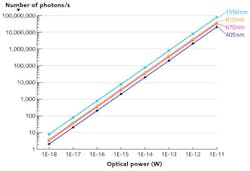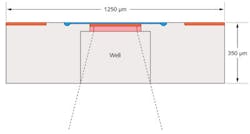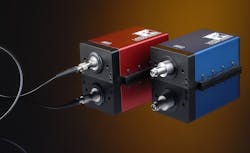PHOTON COUNTING: Improved APD design boosts photon-counting detector efficiency

MIKE HODGES
Scientists and engineers routinely rely on single-photon counting when detection of extremely weak light signals is required and traditional detectors are unable to distinguish between signal and noise. Photon-counting techniques can be found in various areas of industry, research, and communication technology, with specific applications including astronomical lidar, fluorescence microscopy in many different forms, industrial particle sizing techniques, drug discovery, DNA analysis, and, more recently, quantum cryptography.
Although the specific requirements of these applications may differ considerably and a detailed analysis is beyond the scope of this article, they all have one thing in common: the need for a highly efficient, low-noise single-photon detector.
In single-photon counting, the number of photons per second corresponding to a particular optical power level can be expressed as
where P is the optical power in watts and λ the wavelength in nanometers. For example, 1 fW at 405 nm corresponds to roughly 2000 photons/s, whereas a count rate of 100 photons/s at 670 nm corresponds to a power level of merely 30 aW (see Fig. 1).
Photon-counting technologies
Numerous types of single-photon detectors exist, each with their own set of unique properties. The photomultiplier tube (PMT) is a special form of vacuum tube that converts an incoming photon into an electron that is internally amplified by a so-called electron multiplier. The electron multiplier contains a series of secondary electrodes known as dynodes, each of which emits additional electrons upon absorption of incoming electrons, thus creating an avalanche effect.
The dynodes are maintained at a certain electrical potential, which increases from dynode to dynode in order to accelerate the electrons through the PMT to the anode, where they are absorbed, generating an output signal in the form of an electrical pulse. This requires a high voltage of typically 1–3 kV to be applied to the PMT.
A PMT may be used in Geiger mode to detect single photons; however, the very high internal current generated requires the device to be electrically reset following each photon event, leading to a dead time during which no further photon can be observed. While various cathode materials with differing spectral characteristics may be used depending on the wavelength range to be detected, traditional vacuum PMTs generally exhibit the best sensitivity in the shorter-wavelength blue and UV ranges. Photomultiplier tubes generally feature relatively large active areas (several millimeters in diameter) but often have high dark-noise levels and are prone to afterpulsing, an effect whereby a spurious output pulse is emitted although no photon has been detected.
More recently, CMOS-based multipixel Geiger-mode silicon avalanche photodiodes (APDs), often referred to as "silicon photomultipliers," have also been developed. This technology appears promising, with advantages such as a relatively low production cost thanks to conventional CMOS fabrication techniques, low operating voltage, compact construction with a large overall active area, and good timing resolution.
Avalanche photodiodes are highly sensitive photodiodes with very fast response times. Unlike normal p-i-n diodes, the APD uses internal gain to create an avalanche of electron-hole pairs by impact ionization. Prerequisite to this is a sufficiently high bias voltage to widen the absorption region of the APD to allow sufficient electron/hole ionization to occur. When operated below the breakdown voltage, the avalanche soon extinguishes itself due to friction losses within the semiconductor.
Specially constructed APDs may also be used in Geiger mode, in which the bias voltage is set above the APD's breakdown voltage, enabling the avalanche to be maintained and an internal gain of up to 108 to be achieved. Such APDs are commonly referred to as single-photon avalanche diodes (SPADs).
To date, the dark noise for Geiger-mode SPADs is orders of magnitude lower than for conventional APDs; this and the low quantum efficiency of conventional APDs at longer wavelengths mean that single-element SPADs are superior for most single-photon-counting applications.
Geiger-mode operation of a SPAD at high gains inevitably leads to very high current levels within the APD, which must be kept under control using an appropriate quenching circuit to prevent damage to the device. In its simplest form, the quenching circuit may be based on a current-limiting resistor placed in series with the photodiode, which will quench the avalanche if the resistor value is sufficiently large. However, such circuits typically have a long recovery time, which limits the effective maximum count rate.1
For this reason, most commercially available SPAD modules feature active-quenching circuitry that detects the onset of the avalanche and then drops the APD bias to below the breakdown voltage within a few nanoseconds. The result is a relatively short dead time (typically around 50 ns), after which the bias voltage is returned to the previous level, allowing the next photon event to be registered. In this way, maximum count rates of 10 MHz and upward can be easily achieved.
The best SPAD modules currently available exhibit dark-count rates of fewer than 10 counts/s, which corresponds to a dynamic range in excess of 106. Commercially available SPAD modules combine a thermoelectrically cooled Geiger-mode APD with an optimized active-quenching circuit in a compact form factor to allow the user to achieve optimum performance from the SPAD.
Detection efficiency: The key to performance
Several figures of merit may be used when comparing the suitability of detectors for photon counting. Dark noise, afterpulsing probability, and dead time are all important, but for most applications the detection efficiency is paramount. For this reason, SPADs are often considered preferable to PMTs because of their very high quantum efficiency (QE) across a broad spectral range from around 300 nm into the near-infrared (NIR).
Typically, the sensitivity of a photon-counting module will be given as QE, or the ratio of generated electrons to absorbed photons expressed as a percentage value. Manufacturers of certain devices prefer to specify a responsivity (in A/W), which is related to the QE by
where Ro is the responsivity in A/W and λ the wavelength in nanometers. When comparing devices with similar noise performance and afterpulsing probability, the detector with the highest QE will be generally be best suited for photon counting.
It should be noted that the QE is an expression of the efficiency of the APD only, whereas in a complete SPAD module other factors such as electronics can also influence the overall performance slightly. For this reason, data sheets for SPAD modules often state a photon-detection efficiency (Pd) or a probability, the latter of which is the percentage probability of an incident photon generating an electrical pulse at the module output.
When designing a SPAD, it is important to keep in mind that both detection efficiency and dark-count rate depend on the bias voltage applied to the APD. As discussed earlier, the APD is operated in Geiger mode above the breakdown voltage (Vop > Vbr), where the difference between Vop and Vbr is known as the overvoltage, which can be tweaked to optimize a particular parameter (see table).However, optimization can only succeed if the underlying APD design is of a sufficiently high quality, which requires an APD structure designed for maximum quantum efficiency while keeping the semiconductor's K factor (the ratio of hole to electron ionization properties) at a minimum to reduce noise.2 Laser Components Detector Group's Very Low K (VLoK) APD was designed specifically for photon counting and enables SPAD modules with dark-count rates of <10 counts/s and detection efficiencies >80% at a 670 nm wavelength.
Although the majority of SPAD development effort to date has been focused on silicon-based devices, increasing interest in single-photon counting at longer wavelengths has also resulted in the emergence of Geiger-mode indium gallium arsenide (InGaAs) APDs. These can be operated at detection efficiencies up to 20% or higher, albeit with significantly higher dark-count rates than their silicon counterparts. Their development has been primarily driven by advances in quantum-cryptography techniques, where transmission of data over long ranges via optical fibers is necessary; here the high efficiency of silicon detectors is canceled out by high fiber-transmission losses at shorter wavelengths, whereas the superior fiber transmission at 1550 nm more than compensates for the lower QE of the InGaAs detector.
REFERENCES
1. M. Stipcevic et al., Opt. Exp., 18, 17448 (2010).
2. P.P. Webb et al., "Properties of Avalanche Photodiodes," RCA Review, 35, 234-278 (June 1974).
Mike Hodges is a sales engineer at Laser Components GmbH, Olching, Germany; e-mail: [email protected]; www.lasercomponents.com.


